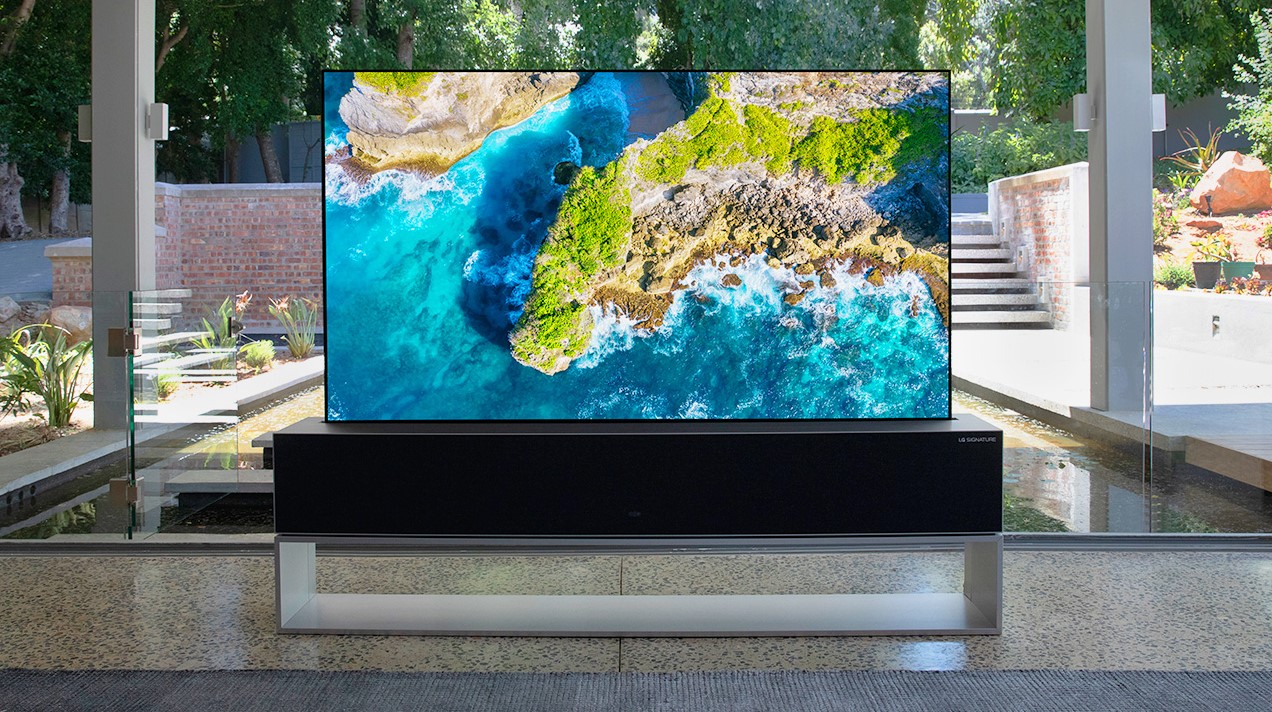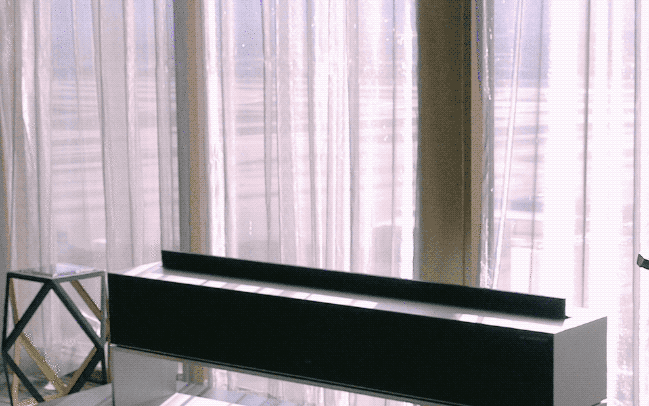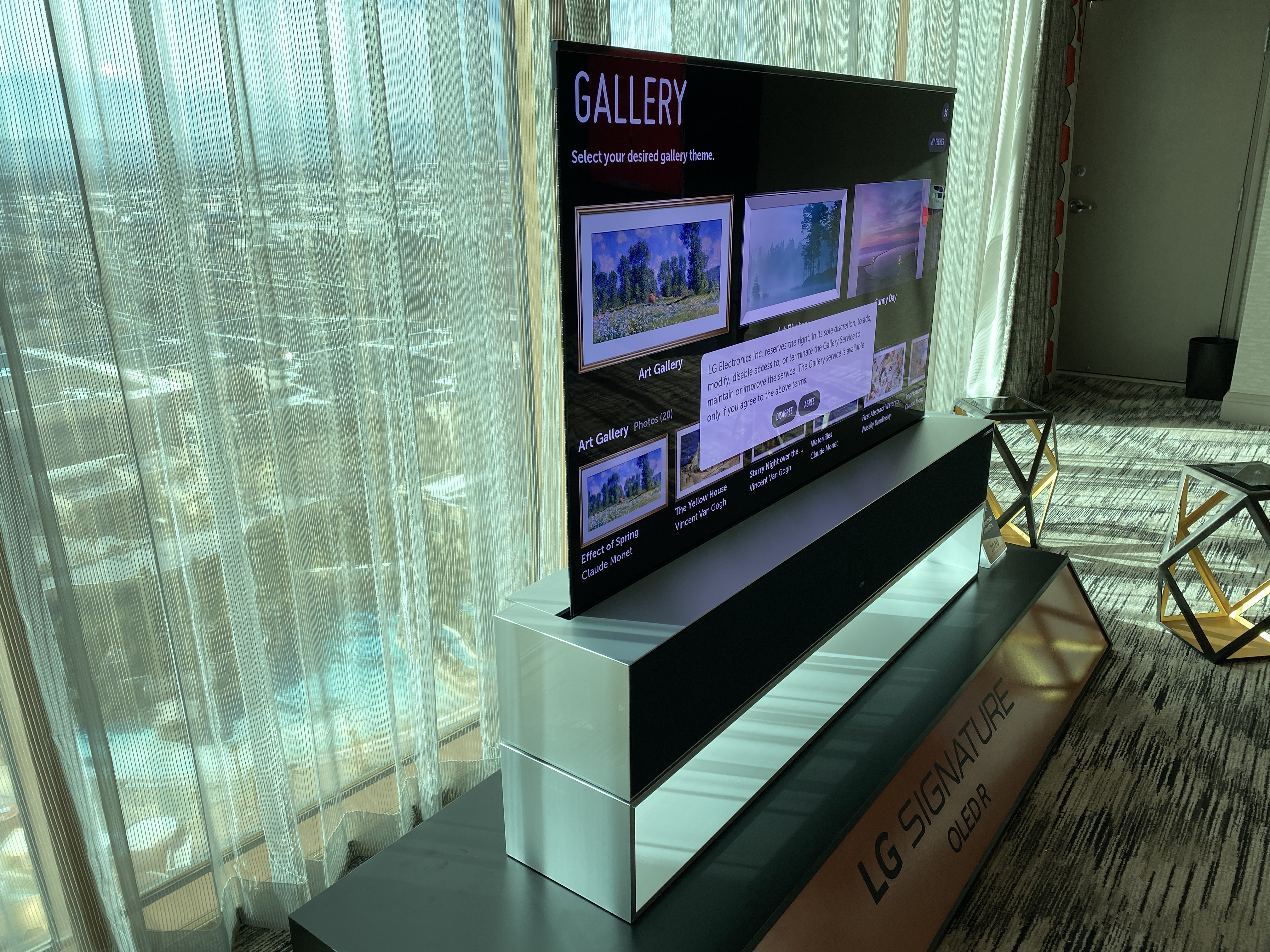LG Rollable OLED TV is priced so high that you’ll think it’s a joke
LG's rollable OLED TV is finally starting to sell, but at these prices, who's buying?

LG's magical-looking rollable OLED TV – officially named the LG Signature OLED R – has been nearly a reality for years. Marrying flexible glass and OLED technology to segmented circuitry and a stylish base that houses the TV when not in use, it's hard to overstate how supremely cool the Rollable OLED TV is in person.
LG's own product page for the TV uses phrases like "A vision of the future" and "All your dreams rolled into one" to really stress the futuristic and aspirational appeal of the flexible screen and motorized action of the TV. And it now has an aspirational price to match.
- The best TVs right now
- OLED vs microLED: Which TV tech will win?
- Plus: Naim’s wooden wireless speaker could class up your home
In 2018 we called LG rollable OLED jaw-dropping, and were giddy at rumors that it would go on sale in 2019. (It did not.) We got our first real hands-on with the set in 2019, and were thrilled to hear it would be coming in 2020. (Again, it didn't.)
We were a little put off by early price leaks suggesting the Rollable OLED could cost $60,000 but when it finally started selling in Korea for $100,000, we were just happy that it was finally going to be a reality.

Well, we've now got our first indications that the LG Signature OLED R will be reaching non-Korean markets — for real, this time — and we regret to inform you that it will, indeed, be stupidly expensive. T3 reports that the LG Rollable OLED is going to start selling in the UK for £99,999.
Whether that means we'll be getting the LG Signature OLED R in the U.S. for the previously suspected $100,000 or the $138,000 that the British price would be in U.S. dollars is yet another unanswered question. And while we're playing games with guessing prices, the Korean sales price for the rollable OLED is 100 million won, which as of this writing was equivalent to $88,695.
But with a possible price ranging from roughly $90,000 to $160,000, I've got a good guess about how well it will sell.
Sign up to get the BEST of Tom's Guide direct to your inbox.
Get instant access to breaking news, the hottest reviews, great deals and helpful tips.
Just a month ago, business publication Korea JoongAng Daily reported that South Korean sales of the rollable OLED had reached a grand total of ten units. In all of South Korea, with a population of more than 51 million, on LG's home turf, the most magical TV we've ever seen struggled to reach double-digit sales by the narrowest margin there is.
At this point, I have to mention that, while watching the TV rise up out of its stylish housing and unfurl into the slickest looking 65-inch TV I've ever seen, it was an undeniably cool trick, but I don't see it being worth 90 grand. Or 150 grand. Or wherever the price of the LG Signature OLED R lands when it finally reaches shoppers stateside.
In fact, once the wow factor wore off after the first couple of openings and closings, I was struck by two thoughts. First, I thought "Wow, I hope you can turn it off without rolling it up, because that's a lot of waiting when you just want to watch TV." My second thought was "I wonder what the warranty on this will be?"
LG OLED R: Multiple points of failure

Because as cool as that rolling screen is, that's a lot of moving parts. There's the rolling screen itself, curling and unfurling, again and again, stressing the glass and OLED layer that's bonded to it. There's the slats of the segmented circuitry behind the screen. Then there's the extending arms that raise it up, and the motor(s) that drive the whole thing.
In the world of product design, these are called points of failure. Moving parts stop moving smoothly. They start showing damage from the stresses of daily use. Vibrations can disrupt other parts of the machine, like the electronics. Things wear out faster when they move, as a rule, and it's especially true with consumer electronics.
One-year warranty? Seriously?!

But let's just assume that LG's engineers have solved these problems. Let's assume that you don't have to wait for a physical process that will rival the most boring loading screens and boot times of any device you own, and let's give LG the benefit of the doubt that it has expert engineers that have guaranteed the physical parts of the rolling TV won't wear out before the expected life of the TV.
Samsung estimates that the average usable life for it's 4K TVs is 7 years. According to a report from The Korea Times, LG's OLEDs have increased in life expectancy from 36,000 hours to over 100,000 hours – nearly 30 years if watched 10 hours a day. But that may be significantly less when you factor in issues like color drift, reduced brightness over time, or burn-in, all issues that plague OLED displays over long term use.
OLED TVs have only been selling for the last 8 years, so we don't actually know that OLED screens last longer than the LCD panels that Samsung's estimates are based on. And even with the nicest fanciest OLED, it's still reasonable to think that it might get replaced in 4 or 5 years. But the warranty on an LG OLED TV? Well, that's just one year.
There's better LG OLED TVs for your money
But the biggest sticking point for pretty much everybody is obviously going to the price. Even if we assume that he initial $60,000 price leak is correct (though we can be pretty confident it's not), that's still a far cry from LG's other most premium sets.
LG's most expensive regular OLED TV, the LG G1 OLED, is available in a 75-inch size for $4,499. It's not only larger than the 65-inch OLED R, it's also got a better display, with LG's newer OLED evo technology offering better brightness and color, all in a slim 20-millimeter design. You can buy buy a dozen of these instead of one rollable conversation piece.
The largest size of the LG Signature ZX 8K OLED, the 88-inch OLED88ZXPUA, sells for $29,999. Depending upon which rumored price we're using for the LG Rollable TV, you can by two or three or four or five of these giant 8K OLED TVs for the same money.
It's the same complaint I had when pricing for the Samsung MicroLED came out – How game changing can technology be if it's priced out of the game? If a technology is so expensive that virtually nobody will ever buy it, what impact will that product make?
Paving the way for affordable rollables?
The best answer is that the expensive proof-of-concept funds the next step of R&D, letting manufacturers refine their manufacturing processes and recoup some initial investment so that it can develop further. And often, an innovation in one product will often show up in a different product later as the lessons from one inform the other, as with LG's Rollable phone – except it looks like that (and every other LG phone) may not stick around for long as LG's entire phone division has an uncertain future.
Maybe that's still true. Perhaps LG will learn lessons from this fancy TV that will make it cheaper in the future, or help other products get better, or even open up possibilities for entirely new categories in the coming years. There are a lot of lessons that can be learned from bleeding edge technology.
But the bigger lesson I think TV manufacturers will have to learn the hard way this year: Six-figure TV prices aren't remotely realistic.
Brian Westover is currently Lead Analyst, PCs and Hardware at PCMag. Until recently, however, he was Senior Editor at Tom's Guide, where he led the site's TV coverage for several years, reviewing scores of sets and writing about everything from 8K to HDR to HDMI 2.1. He also put his computing knowledge to good use by reviewing many PCs and Mac devices, and also led our router and home networking coverage. Prior to joining Tom's Guide, he wrote for TopTenReviews and PCMag.

